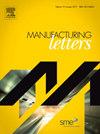振荡磁场辅助整理定向能量沉积 NASA HR-1 积分通道的特征
IF 2
Q3 ENGINEERING, MANUFACTURING
引用次数: 0
摘要
增材制造(AM),如定向能沉积(DED),能以接近净形的方式制造复杂几何形状的关键零件,但需要进行后处理,以实现所需的几何形状和性能。特别是,使用定向能沉积技术制造的零件有时会打印出较高的初始表面粗糙度,这就需要进行后处理,以满足与应用相关的要求。磁场辅助精加工(MAF)是通过磁力操纵磁性抛光工具,使其产生与目标表面的相对运动,已被应用于光滑的 AM 零件。磁场辅助抛光的优点是磁力操纵的抛光工具既能抛光零件外表面,也能抛光零件内部。本文提出了一种摆动磁性抛光工具,用于平滑使用 DED 制作的矩形 NASA HR-1 合金通道的内表面。由于有效的工具运动可以减少表面粗糙度和波纹,因此控制抛光工具运动的参数非常重要。本文介绍了控制抛光工具运动的三个参数:抛光工具数量、磁场和研磨浆。结果表明,抛光工具运动对抛光特性的影响可以将通道内表面的粗糙度从几十微米降低到亚微米级。本文章由计算机程序翻译,如有差异,请以英文原文为准。
Characterization of oscillatory magnetic field-assisted finishing of directed energy deposition NASA HR-1 integral channels
Additive manufacturing (AM), such as directed energy deposition (DED), enables fabrication of complex geometries for critical parts at near-net shape, but creates a need for post-processing to achieve desired geometry and performance. In particular, parts made using DED are sometimes printed with a high initial surface roughness, requiring post-processing to meet application-dependent requirements. Magnetic field-assisted finishing (MAF), in which a magnetic polishing tool is manipulated by magnetic force and generates relative motion against a target surface, has been applied to smooth AM parts. An advantage of MAF is that the magnetically manipulated polishing tools can finish both external part surfaces and part interiors. In this paper, an oscillating magnetic polishing tool is proposed to smooth the inner surfaces of rectangular NASA HR-1 alloy channels made using DED. Because effective tool motion allows reduction of surface roughness and waviness, parameters that control polishing-tool motion are of great interest. This paper describes three parameters that control polishing-tool motion: number of polishing tools, magnetic field, and abrasive slurry. The effects of tool motion on the polishing characteristics are demonstrated, showing that the roughness of the interior channel surface can be reduced from several tens of micron to a sub-micron level.
求助全文
通过发布文献求助,成功后即可免费获取论文全文。
去求助
来源期刊

Manufacturing Letters
Engineering-Industrial and Manufacturing Engineering
CiteScore
4.20
自引率
5.10%
发文量
192
审稿时长
60 days
 求助内容:
求助内容: 应助结果提醒方式:
应助结果提醒方式:


